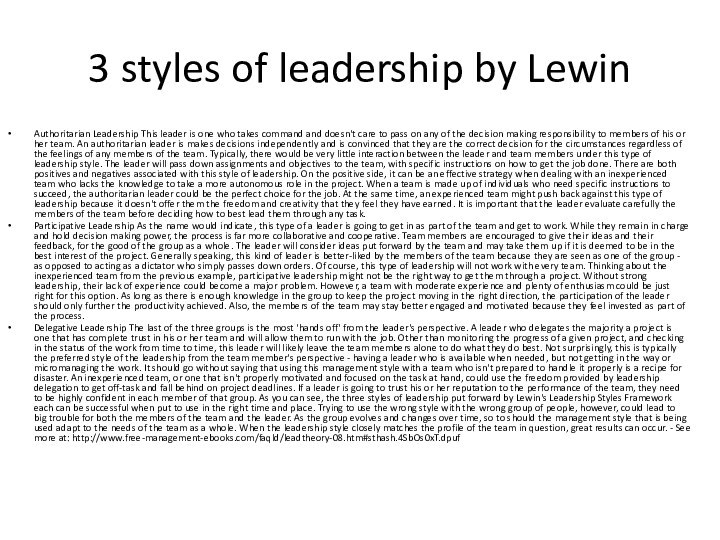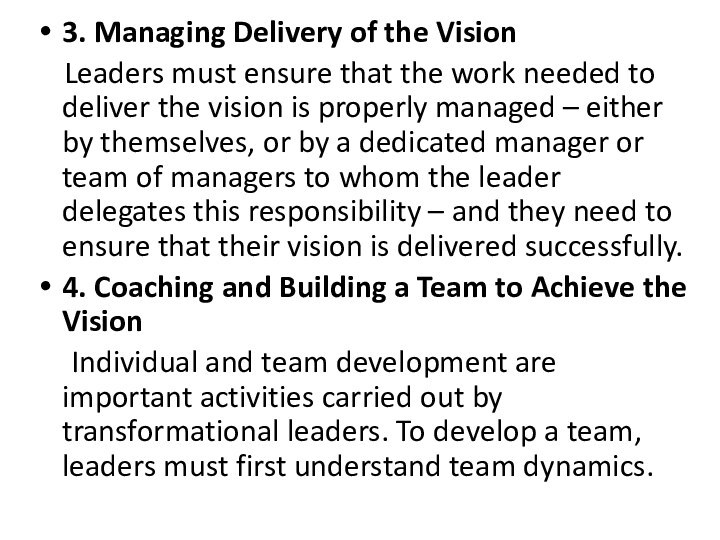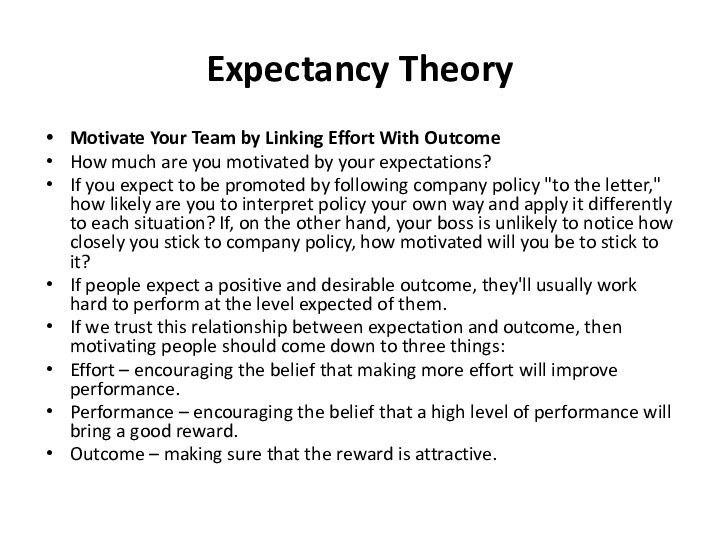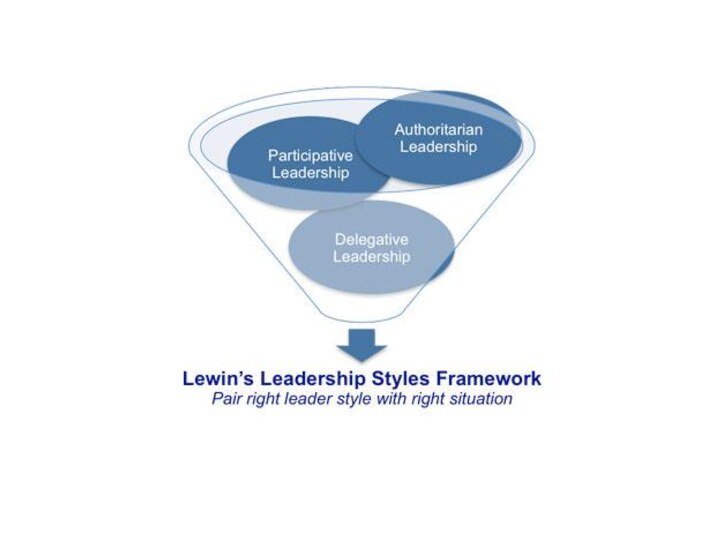Слайд 2
Leadership: A Definition?
According to the idea of transformational leadership ,
an effective leader is a person who does the
following:
Creates an inspiring vision of the future.
Motivates and inspires people to engage with that vision.
Manages delivery of the vision.
Coaches and builds a team, so that it is more effective at achieving the vision.
Leadership brings together the skills needed to do these things. We'll look at each element in more detail.
Слайд 3
Main competencies of leader
1. Creating an Inspiring Vision
of the Future
In business, a vision
is a realistic, convincing and attractive depiction of where you want to be in the future. Vision provides direction, sets priorities, and provides a marker, so that you can tell that you've achieved what you wanted to achieve.
2. Motivating and Inspiring People
A compelling vision provides the foundation for leadership. But it's leaders' ability to motivate and inspire people that helps them deliver that vision.
Слайд 4
3. Managing Delivery of the Vision
Leaders
must ensure that the work needed to deliver the
vision is properly managed – either by themselves, or by a dedicated manager or team of managers to whom the leader delegates this responsibility – and they need to ensure that their vision is delivered successfully.
4. Coaching and Building a Team to Achieve the Vision
Individual and team development are important activities carried out by transformational leaders. To develop a team, leaders must first understand team dynamics.
Слайд 5
Expectancy Theory
Motivate Your Team by Linking Effort With
Outcome
How much are you motivated by your expectations?
If
you expect to be promoted by following company policy "to the letter," how likely are you to interpret policy your own way and apply it differently to each situation? If, on the other hand, your boss is unlikely to notice how closely you stick to company policy, how motivated will you be to stick to it?
If people expect a positive and desirable outcome, they'll usually work hard to perform at the level expected of them.
If we trust this relationship between expectation and outcome, then motivating people should come down to three things:
Effort – encouraging the belief that making more effort will improve performance.
Performance – encouraging the belief that a high level of performance will bring a good reward.
Outcome – making sure that the reward is attractive.
Слайд 6
3 styles of leadership by Lewin
Authoritarian Leadership This

leader is one who takes command and doesn't care
to pass on any of the decision making responsibility to members of his or her team. An authoritarian leader is makes decisions independently and is convinced that they are the correct decision for the circumstances regardless of the feelings of any members of the team. Typically, there would be very little interaction between the leader and team members under this type of leadership style. The leader will pass down assignments and objectives to the team, with specific instructions on how to get the job done. There are both positives and negatives associated with this style of leadership. On the positive side, it can be an effective strategy when dealing with an inexperienced team who lacks the knowledge to take a more autonomous role in the project. When a team is made up of individuals who need specific instructions to succeed, the authoritarian leader could be the perfect choice for the job. At the same time, an experienced team might push back against this type of leadership because it doesn't offer them the freedom and creativity that they feel they have earned. It is important that the leader evaluate carefully the members of the team before deciding how to best lead them through any task.
Participative Leadership As the name would indicate, this type of a leader is going to get in as part of the team and get to work. While they remain in charge and hold decision making power, the process is far more collaborative and cooperative. Team members are encouraged to give their ideas and their feedback, for the good of the group as a whole. The leader will consider ideas put forward by the team and may take them up if it is deemed to be in the best interest of the project. Generally speaking, this kind of leader is better-liked by the members of the team because they are seen as one of the group - as opposed to acting as a dictator who simply passes down orders. Of course, this type of leadership will not work with every team. Thinking about the inexperienced team from the previous example, participative leadership might not be the right way to get them through a project. Without strong leadership, their lack of experience could become a major problem. However, a team with moderate experience and plenty of enthusiasm could be just right for this option. As long as there is enough knowledge in the group to keep the project moving in the right direction, the participation of the leader should only further the productivity achieved. Also, the members of the team may stay better engaged and motivated because they feel invested as part of the process.
Delegative Leadership The last of the three groups is the most 'hands off' from the leader's perspective. A leader who delegates the majority a project is one that has complete trust in his or her team and will allow them to run with the job. Other than monitoring the progress of a given project, and checking in the status of the work from time to time, this leader will likely leave the team members alone to do what they do best. Not surprisingly, this is typically the preferred style of the leadership from the team member's perspective - having a leader who is available when needed, but not getting in the way or micromanaging the work. It should go without saying that using this management style with a team who isn't prepared to handle it properly is a recipe for disaster. An inexperienced team, or one that isn't properly motivated and focused on the task at hand, could use the freedom provided by leadership delegation to get off-task and fall behind on project deadlines. If a leader is going to trust his or her reputation to the performance of the team, they need to be highly confident in each member of that group. As you can see, the three styles of leadership put forward by Lewin's Leadership Styles Framework each can be successful when put to use in the right time and place. Trying to use the wrong style with the wrong group of people, however, could lead to big trouble for both the members of the team and the leader. As the group evolves and changes over time, so to should the management style that is being used adapt to the needs of the team as a whole. When the leadership style closely matches the profile of the team in question, great results can occur. - See more at: http://www.free-management-ebooks.com/faqld/leadtheory-08.htm#sthash.4SbOs0xT.dpuf
Слайд 8
Leadership, and how can we understand it
Leadership
can be hard to define and it means different
things to different people.
In the transformational leadership model, leaders set direction and help themselves and others to do the right thing to move forward. To do this they create an inspiring vision, and then motivate and inspire others to reach that vision. They also manage delivery of the vision, either directly or indirectly, and build and coach their teams to make them ever stronger.







































